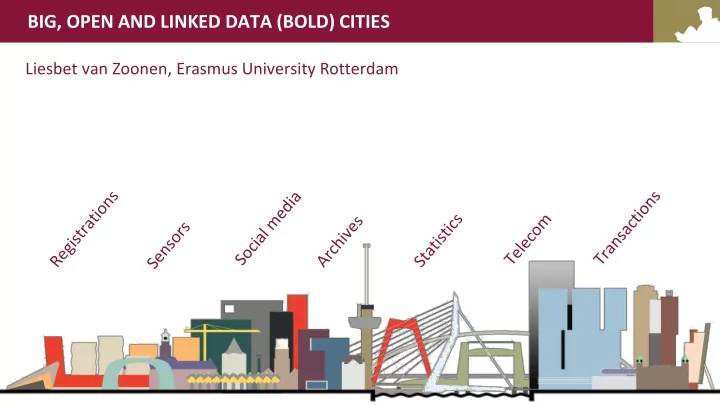

BIG, OPEN AND LINKED DATA (BOLD) CITIES Liesbet van Zoonen, Erasmus University Rotterdam
BOLD CITIES: MULTIPLE STAKEHOLDERS AND CONNECTIONS Rotterdam Regional Erasmus Universiteit BOLD Ci KWP TU Delft Knowledge Lab UBD Universiteit van Leiden ties Urban Big Data DARE Odissei Data Alliance Office of Dutch Statistics Rotterdam Erasmus Big Data Data platform Social Sciences Rotterdam National
WHERE ????
OUR RESEARCH BOLD Trials - Big data for vulnerable groups
BIG DATA FOR VULNERABLE GROUPS • People on benefits • Personalising reintegration – linking data - Rotterdam • Predicting fraud risk – machine learning - Rotterdam • Working poor • Preventing poverty plunge – linking data – The Hague • Young people • Finding NEETS – geo and social urban data - Rotterdam
OUR RESEARCH Data Empowerment BOLD Trials - Civil service lags behind - Big data for vulnerable groups - Co-creation with municipality - Technical and analytical challenges - Data dialogues - Ethical and epistemological issues - Data walks - Cost-benefit assessment
WALKING • Big Four: Amsterdam, Rotterdam, Utrecht, Den Haag 16 groups of about 5 people each • Contrast group of 20 students • • Questions What do you see: digital, datafied, smart, etcetera? • What is its purpose, goal, usage • Who owns it? • Which are the public interests/values at stake? •
WHY WALK? • Common method in urban studies City is embodied experience • • Contrast Smart city, datafication and digitization = invisible, disembodied • • Action research: Identify and generate collective knowledge • Raise awareness, invite reflection • • Towards designing a data empowerment tool
WHAT DO YOU SEE? CCTV, traffic cameras, sensors, lamp posts, ATM’s, mobil e phones, free Wi-Fi, pa rking meters and garages, stock management in stores, customer loyalty cards, t elecom masts, antennas, building permits, boat permits, cadastre, police cars, cars, some bicycles, post and package delivery, selfies, unknowns and invisibles Connected measuring tube groundwater level
PURPOSE AND USAGE
PURPOSE AND USAGE (Say they) Know Have some sense Claimers Sector Know nothing Or a hunch specialists much NOBODY HAS A FULL PICTURE
WHO OWNS THE DATA? • Municipal silos Public transport, Environment, Harbour, Public health • • QUESTIONS, QUESTIONS, QUESTIONS Cameras > public or private? Regulation? • Residential buildings with electronic door systems • When can the police request data? • NOBODY HAS A FULL PICTURE
PUBLIC VALUES AND INTERESTS • Transparency comes before privacy Strong belief in existing and upcoming regulation (GDPR) • Privacy officers regularly experienced as limiting • • Who is responsible for transparency Individual frameworks • I should know more, better • It does not affect me (students) • No sense of collective or political responsibilities (civil servants) • • Generic focus on citizen participation and engagement Little sense of why, how and tensions (Netherlands) •
NEXT STEPS • Design training and teaching instrument Guided tour for professionals, students and pupils • Use also as data collection • • Elaborate co-creation and data literacy Boundary crossing: safe/unsafe, privacy/surveillance • Working with vulnerable youth • • Health warnings for civil servants • Epistemological and control fallacies • Cost effectiveness • Theorize and publish
ACADEMIC CONTEXT • Multistakeholder governance Meijer, A., & Bolívar, M. P. R. (2016). Governing the smart city: a review of the literature • on smart urban governance. International Review of Administrative Sciences , 82 (2), 392-408. • Actor network theory Campbell, T. (2013). Beyond smart cities: how cities network, learn and innovate . • Routledge. • Innovation studies Leydesdorff, L., & Deakin, M. (2011). The triple-helix model of smart cities: A neo- • evolutionary perspective. Journal of Urban Technology , 18 (2), 53-63. • Critical data studies Kitchin, R. (2014). The real-time city? Big data and smart urbanism. GeoJournal , 79 (1), • 1-14.
THANK YOU www.centre-for-bold-cities.nl Vanzoonen@egsh.eur.nl
Recommend
More recommend